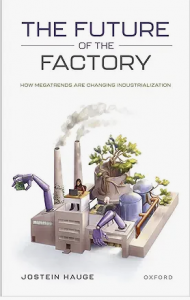I’ve been dipping into the proofs of a substantial book, Industrial Policy for the United States by Marc Fasteau and Ian Fletcher, due out in September. It will prove a significant resource for anybody interested in the issue. The book starts with the economic case for strategic government interventions in the supply side structure, arguments that have been gaining traction recently as the utlra-free marketism paradigm fades in the US and elsewhere. The authors focus particularly on increasing returns and technological innovation.They bring a certain zero sum mentality to the analysis – the US must win, other countries must lose – which I don’t share; the technological frontier is broad and granular. But the demolition of the idea that a ‘free’ market is the way to organise the economy at a time of significant structural change is spot on.
The second section explores brief country case studies (“Chapter 10, Britain: No Theory and Little Execution” puts it in a nutshell for the UK: “Britain has become a byword for ineffective industrial policy.”). These are for the most part short factual histories for readers who have no prior knowledge of the countries concerned, with an introductory commentary. The book is wholly US-focused.
The third section is a history of industrial policy in the US from colonial times and Hamilton onwards, while the fourth moves into the US innovation system. It paints a picture of government support for innovation as a de facto industrial policy even during periods when political rhetoric emphasised markets. And it describes the innovation system as the ultimate private-public partnership. The section argues the case for a shift to more active Federal government innovation programmes using both market-creating policies, innovations induced by regulatory requirements and a role for novel types of innovation organisation in the system – manufacturing institutes, for example.
The final two sections consist of industry case studies and regional case studies. In the former are the well-known semiconductor example, and also nanotechnology (“Is America Losing the Future?”, this one is titled. The regional examples are life sciences in Massachussetts and emiconductors in upstae New York.
The book ends with recommendations for the US. While welcoming the Biden policies, the CHIPS and the Inflation Reduction Act, the authors want more: “The challenge now is to maje industrial policy comprehensive, coherent, institutionalized, and a fixture of the policy consensus.” The US needs to focus on its most dynamic industries and develop them as oligopolies to enjoy economies of scale and the profitability for continuing innovation, they argue. They see a national security as well as an economic need for the US to stay at the frontier in multiple industries – just as the Cold War imperatives drove policy in the 1950s and 60s. The final chapter has a lengthy set of specific recommendations for different actors in the US political and industrial systems.
At 670 pages of text and 150 pages of notes and bibliography, has the obvious advantages and disadvantages of its sweep and scale – a superb place to start on any aspect of US industrial policy, but only a starting point for depth on any particular aspect. I found the parts I’ve read very interesting given my relative lack of knowledge about the institutional and historical details in the US. But I applaud the ambition and think the historical perspective suggests the authors are right in drawing a curtain on what – it turns out – is the aberrational period of policy free-marketism.


